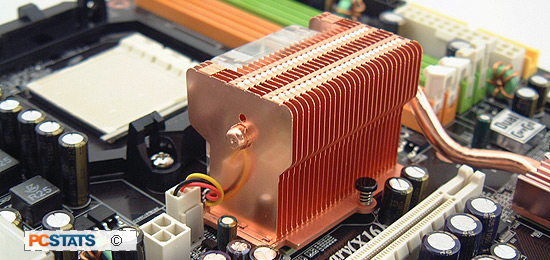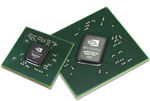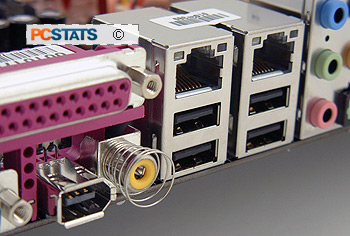
|
If you're a gamer, multimedia enthusiast, or future indie rock star mixing tracks for your debute CD, the MSI K9N Diamond is a board well worth your attention.
80% Rating: 
|
|
|
|
Home >
Reviews >
Motherboards >
MSI K9N Diamond |
|
|
Flagship AM2 Chipset - nForce 590 SLI
The flagship
nVIDIA nForce 590 SLI chipset is
aimed directly at the enthusiast market. If you want the best, this
chipset is your only alternative for an AM2-based system unit VIA or SIS get
their act together. If you are already familiar with what the nForce 590 has
to offer, feel free to jump ahead to the next page of this MSI K9N Diamond
motherboard review. nVIDIA breaks
the nForce 590 SLI down into two chipsets, the C51XE Northbridge which is built
on TSMC's 90nm manufacturing, and the MCP55PXE which is manufactured on TSMC's
140nm manufacturing.

The nVIDIA
nForce 590 SLI chipsets have a total of 46 PCI Express lanes available, and
these are divided into 9 links. The C51XE SPP Northbridge supplies one PCI
Express x16 link while it's the MCP55PXE that has the rest of the PCI Express
lanes. The MCP55PXE also supports one PCI Express x16 link, which means users
get full videocard bandwidth when running two nVIDIA videocards in
SLI.
 The MCP
Southbridge has a PCI Express x8 link and six PCI Express x1 links, depending on
what the motherboard vendor decides to implement. Whichever way you slice it,
there's plenty of high bandwidth PCI Express lanes to go
around! The nVidia
MCP55PXE Southbridge is definitely the workhorse of the two, and it boasts a
whole host of other features as well. The Southbridge handles up to 5 bus
mastering PCI slots, but again it's up to the motherboard manufacturer to decide
how many PCI slots to equip on a motherboard. There is a direct link to the
Southbridge for two Gigabit Ethernet connections, and these will include
nVIDIA's DualNet technology of course. The MCP
Southbridge has a PCI Express x8 link and six PCI Express x1 links, depending on
what the motherboard vendor decides to implement. Whichever way you slice it,
there's plenty of high bandwidth PCI Express lanes to go
around! The nVidia
MCP55PXE Southbridge is definitely the workhorse of the two, and it boasts a
whole host of other features as well. The Southbridge handles up to 5 bus
mastering PCI slots, but again it's up to the motherboard manufacturer to decide
how many PCI slots to equip on a motherboard. There is a direct link to the
Southbridge for two Gigabit Ethernet connections, and these will include
nVIDIA's DualNet technology of course.
| nVidia nForce 500 Series Feature
Breakdown |
|
nVidia nForce 590
SLI |
| CPU |
940-pin Socket AM2 |
| nVida SLI Support |
Yes, (2 x16) |
| nVidia LinkBoost |
Yes |
| nVidia FirstPacket |
Yes |
| nVidia DualNet |
Yes |
|
Native Gigabit Ethernet |
2 |
|
Teaming |
Yes |
|
TCP/IP Acceleration |
Yes |
| nVidia MediaShield Storage |
Yes |
|
SATA/IDE HDD |
6/2 |
|
SATA Speed |
3Gb/s |
|
RAID |
0, 1, 0+1, 5 |
| nVidia nTune Utility |
Yes |
| PCI Express Lanes |
46 lanes |
| USB Ports |
10 |
| PCI Slots |
5 |
| Audio |
High Definition Audio
(Azalia) | |
nForce 590 SLI
Assorted Technologies
nVIDIA has
upgraded the integrated audio solution to include Intel's High Definition Audio
Azalia standard. In the case of the MSI K9N Diamond though, MSI has decided to
go with a Creative SoundBlaster Audigy SE hardware sound card instead. With
Serial ATA going the way it is, there is only one IDE channels integrated now.
To balance out storage requirements, the number of Serial ATA II (3Gbps) ports
has been increased to six. Continuing on the hard drive front, nVIDIA's Serial
ATA II channels adhere to the Serial ATA 2.0 spec and support RAID mode 0, 1,
0+1 and 5.
nVIDIA DualNet technology looks very interesting, and
what it does is basically give the user greater control over network processes.
All high end and mainstream nVIDIA chipsets will now by default support two
Gigabit connections. Users can combine the two connections for more bandwidth,
and there is hardware TCP/IP Acceleration which lowers CPU utilization. Another
very cool feature is nVIDIA's FirstPacket Technology which allows you to
prioritize network traffic. So for example, if you are a gamer that tends to do
multiple things while you're online, you can prioritize your game traffic so
that ping times are not affected by the other processes going on in the
background.
When the
nVIDIA nForce 590 SLI chipset is equipped with GeForce 7900GTX class or higher
videocards, the chipset will automatically activate the nVidia LinkBoost
technology. LinkBoost increases
the PCI Express x16 buses to the videocard by 25%, and it also does the same for
the HyperTransport link between the North and  Southbridge chipsets. While increasing the bandwidth PCI Express
bandwidth to GeForce 7900GTX might be a bit redundant, future generation
videocards should see a nice gain from this setting.
Southbridge chipsets. While increasing the bandwidth PCI Express
bandwidth to GeForce 7900GTX might be a bit redundant, future generation
videocards should see a nice gain from this setting.
On the memory
front, the nVidia 590 SLI chipset introduces something called the
Enhanced Performance Profiles or EPP. This is an open memory
standard put forth by Corsair and nVIDIA which takes over where JEDEC's SPD
leaves off. As the Enhanced Performance Profiles description implies, it adds
performance profiles to the memory SPD in addition to the conservative
compatibility settings already programmed in. EPP compliant
memory is dubbed "SLI Ready" memory on nVidia platforms (great marketing on
nVIDIA's part) and allows the system to dynamically tighten up memory timings
and increase voltages for better performance with no fuss. Whether you're a
novice or experienced computer user, the benefits of EPP are immediate. Corsair
is the initial memory manufacturer out the door with this new technology but
others are already following suit.
Finally
nVIDIA has greatly upgraded its nTune software which allow
users more control over their systems. Realistically with nTune, there is no
longer a need to go into the BIOS to adjust settings, now you can do everything
within WindowsXP!Next
up, highlights of the MSI K9N Diamond motherboard.
|
